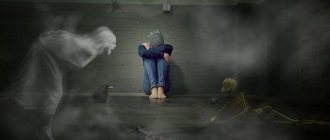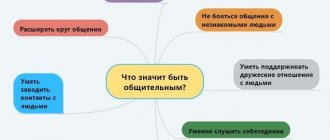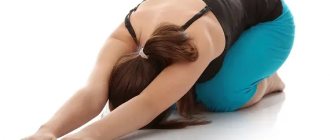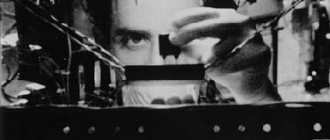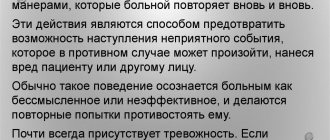- Treatment of panic attacks.
- Mechanisms of panic symptoms.
- Causes of PA.
- Symptoms of PA.
- Types of PA.
- Consequences of PA.
- Treatment of PA at Dr. Minutko’s clinic.
- Prevention of recurrent PA
- How to cope with PA with proper breathing.
- How to deal with PA on your own
A panic attack is a disorder accompanied by anxiety, fear, for no apparent reason.
Panic symptoms occur suddenly. They grow quickly within a few minutes and go away spontaneously. Despite the short duration of the attacks, a person’s experiences can be very difficult. A panic attack can be an independent symptom or associated with a mental illness or somatic pathology. Fear during a panic attack is often accompanied by vegetative manifestations. The disease occurs at the age of 20-25 years, more often in women. According to statistics, every tenth person has experienced symptoms of panic in their life, but this does not mean that it is necessary to use drug treatment methods. The causes of panic attacks can be extreme situations in people's lives, excessive emotional or mental stress. But the diagnosis of “panic disorder” is made only when attacks occur regularly and organic and mental disorders are excluded.
Mechanisms of panic symptoms
At the present stage, there are many hypotheses about the mechanisms of panic attacks, but they all boil down to disruptions in the processes underlying the reaction to stress.
Theories for panic cases:
- genetic theory;
Based on the idea that hereditary factors play a role in the risk of panic attack symptoms. The genes D4S413 and D9S271 are responsible for this.
- receptor theory;
The presence of a certain variant of the serotonin transporter protein (5HT LPR) leads to vulnerability to stress and correlates with the volume of brain gray matter in the amygdala and anterior cingulate gyrus;
- theory of human personality characteristics;
Symptoms of panic occur more often in people who have the following personality traits:
- Hypochondriacity;
- Demonstrativeness;
- I crave recognition;
- Great need to attract attention.
- psychoanalytic theory;
Its founder was Sigmund Freud. A person has natural needs for sex, freedom, aggression, if something affects his interests. Suppression of desires and interests under the pressure of family and social taboos leads to tension and internal conflict, which can develop into a panic attack. If strong experiences occur frequently, then a person may experience fear and a feeling of helplessness, which also provokes symptoms of panic.
- cognitive theory;
It consists of an incorrect interpretation of bodily sensations. Negative thinking contributes to incorrect internal experience, increased fear, which does not correspond to real dangers;
- social theory;
Modern life in a metropolis, pressure, stress, the need to conform to some status cause symptoms of panic not only in adults, but also in children and adolescents. Passing an exam, performing in competitions, fear of punishment, sexual violence cause symptoms of panic attacks;
- behavioral theory;
According to it, any external threatening event can take hold reflexively. For example, seeing a traffic accident causes your heart rate to increase and anxiety to arise. A repeated similar situation can again create an attack of anxiety and an acceleration of the pulse. In the future, a panic attack occurs without external causes;
- catecholamine theory;
Depending on the type of stress, the human body reacts with the release of adrenaline, a substance secreted by the adrenal cortex. It increases heart rate, increases blood pressure, and causes anxiety and fear.
Causes of panic attacks
Identifying the cause of panic is necessary not only for diagnosing the disease, but also for treating panic attacks.
The most likely conditions for panic attack symptoms to occur are:
- emotional long-term stress;
- depression;
- illness of loved ones or death;
- insomnia;
- change of living conditions;
- family problems.
Panic attack symptoms include:
- heart disease (arrhythmia, angina pectoris, myocardial infarction, mitral valve prolapse);
- lung diseases (bronchial asthma, chronic bronchitis);
- organic diseases of the brain (impaired activity of the limbic and reticular structures, diseases of the brain stem, dysfunction of the hypothalamus);
- endocrine pathology (thyroid disease, thyrotoxicosis, pheochromocytoma - tumor of the adrenal glands);
- physiological conditions (childbirth, pregnancy, adolescence, onset of sexual activity, menopause);
- taking certain medications (steroids, bemegride, cholecystokinin);
- mental illnesses (depression, schizophrenia, post-traumatic stress disorder, obsessive-compulsive disorder).
Symptoms of panic attacks
Symptoms of panic attacks are divided into:
- vegetative;
- affective-emotional;
- cognitive;
- conversion.
Vegetative syndromes manifest themselves:
- dizziness, lightheadedness;
- “fading of the heart”, “feeling of a jolt in the area of the heart”, increased heart rate;
- shortness of breath, feeling of lack of air, “lump in the throat,” tightness of the diaphragm;
- increased blood pressure;
- nausea, vomiting, diarrhea, stomach discomfort, flatulence, thirst.
Affective-emotional syndromes manifest themselves:
- fear of death;
- anxiety about unknown danger;
- fear of going crazy;
- fear of loss of control;
- fear of committing an unseemly act (wetting ourselves, throwing ourselves at a person);
- aggression, irritation;
- melancholy, hopelessness, depression, feeling of self-pity.
Cognitive syndromes manifest themselves:
- confusion, narrowing of consciousness;
- derealization, depersonalization - feelings of unreality, instability of the surrounding world, loss of oneself in this world, feeling of one’s own actions from the outside;
Conversion syndromes manifest themselves:
- walking impairment, without organic pathology;
- the presence of a veil before the eyes;
- sharp limitation of visual fields;
- decrease in audibility to a state like “in an aquarium”;
- weakness;
- numbness, feeling of awkwardness, tension.
Symptoms of panic can be present without fear, which is why many patients turn to general practitioners and are diagnosed with various diseases of the cardiovascular or pulmonary system. If there is only one episode of fear, treatment for panic attacks cannot be prescribed. Therapy for panic attacks is prescribed if there are three attacks within three weeks. Correct differential diagnosis allows you to stop the signs of the disease and prevent the occurrence of panic symptoms.
Diagnostics
When diagnosing panic attacks, the presence of somatic diseases related to the thyroid gland, heart and respiratory diseases, and neurological problems is first excluded. The patient is also examined by a psychotherapist for the development of depression, bipolar disorder and psychopathy of various forms. The final diagnosis is made by a psychotherapist after excluding common diseases and mental disorders.
In a number of somatic and mental illnesses, symptoms reminiscent of panic attacks develop. Thus, with bronchial asthma, the patient suffers from suffocation during attacks, but during a panic attack there is no difficulty in exhaling, and wheezing characteristic of asthma is not observed.
With hypertension, attacks of fear develop when crises threaten, but they are always preceded by an increase in pressure. With panic attacks, blood pressure rises during the attack.
The difference between a panic attack and angina pectoris is that pain in the heart during an attack is not relieved by medications for heart pain, the level of markers of myocardial necrosis is within normal limits, and the pain goes away when attention is switched.
After diagnostic examinations, and if somatic causes are excluded, you can begin treatment for the independent disease “panic disorder.”
Consequences of panic attacks
Panic attacks do not go unnoticed on the human psyche. The patient subconsciously waits for repeated attacks, which keeps him “in tension.” This affects his entire life. Relationships in your personal life and professional sphere may be disrupted. Very often, various phobias can arise in parallel with panic attacks. Including agoraphobia - fear of open spaces and crowds of people. Panic attacks in people lead to:
- hypochondria;
- secondary depression;
- the emergence of dependence on alcohol and drugs;
- impaired concentration;
Panic symptoms can cause social isolation, loss of interest in life and lead to disability.
Get to know the essence
As you know, a panic attack occurs groundlessly, without a real threat. She can find her carrier at home watching TV, at work or in her bed at night.
Its main driving factor is fear: death, hopelessness, fainting or having a heart attack. These are the thoughts that visit a panicker at the peak of an attack. They, in turn, trigger a pathological reaction in a circle until the psycho-emotional stress decreases. At the moment of such a cyclical process, there is a certainty that it will never end.
Where does this fear come from? It is provoked by a neurochemical imbalance: the amount of stress hormones (adrenaline, norepinephrine) prevails over serotonin, the hormone of happiness. This happens for various reasons: chronic stress, overwork, sedentary lifestyle, internal conflicts, bad habits, etc.
It is the feeling of fear, fueled by adrenaline, that causes a number of painful physiological symptoms. Among them are suffocation, chaotic fluttering of the heart muscle, profuse sweat, trembling, dizziness. All this is the result of a sharp narrowing of blood vessels and excess oxygen in the blood. Extreme fear drives a person to madness. He does not understand where he is, the world around him seems blurry and unclear.
The fight against a panic attack, as a malicious disturber of a person’s peace, begins when he realizes one fact: this condition is not a sign of a physical illness (if you do not have concomitant diseases). It is impossible to die from it, your heart will not stop, you will not suffocate from lack of air, you will not even faint.
Take and analyze your attack. When it ends, all symptoms go away and your body works smoothly again. The heart does not jump out of the chest, breathing is smooth, blood pressure is normal.
Surely you have already undergone all kinds of examinations, checked every organ, visited all the specialists. If their diagnosis is unanimous and confirms that you are physiologically healthy, shift the focus in the other direction: look for the problem in your head, in your mental state. Understand that a panic attack is the result of a mental imbalance, so it is not the body that needs to be treated, but the soul.
Treatment of panic attacks at Dr. Minutko’s clinic
Any therapy for panic attacks should begin with a diagnosis and search for their causes. Not all attacks are caused by mental pathology; sometimes the cause of panic attacks is a dysfunction of the temporal lobe of the brain. Differential diagnosis of panic attacks should be carried out to distinguish a panic attack as such from similar conditions in diseases of the endocrine, cardiovascular system, neurological, and organic diseases of the brain. It is also necessary to distinguish panic attacks from phobias in cases of schizophrenia, depression, and bipolar affective disorder.
At the clinic of Doctor of Medical Sciences Vitaly Leonidovich Minutko, differential diagnosis of a panic attack is carried out on the basis of objective criteria: blood tests for hormonal status, visceral, neural tests, neuroimaging methods, transcranial magnetic stimulation.
Treatment for panic attacks can be divided into several categories:
- drug therapy in an outpatient or hospital setting;
- non-drug treatment;
- prevention of panic attacks;
- providing emergency assistance;
- methods of relaxation and working with reactions to trigger stimuli.
Therapy for panic attacks is carried out in outpatient and inpatient settings. They are determined both by the patient's intention and the severity of the panic attacks. If a person is so overcome by fear that he cannot stay at home, and attacks occur every day, then it is better to go to the hospital.
Inpatient therapy for panic attacks is prescribed for:
- impossibility of living at home;
- frequently recurring attacks;
- concomitant depression;
- uncertainty about the cause of a panic attack;
- the need for comprehensive diagnostics;
- concomitant alcohol, medication, drug addiction.
Pharmacological treatment of panic attacks is carried out according to indications; in other cases, instrumental psychotherapy (biofeedback sessions) and psychotherapy sessions help.
If the fear is very strong and does not allow a person to leave the house, then in the clinic of Doctor of Medical Sciences Vitaly Leonidovich Minutko there is a service - calling a psychotherapist at home and the opportunity to undergo panic attack therapy at home. Drug therapy for panic attacks allows you to get rid of attacks when combined with behavioral psychotherapy. But it must be remembered that pharmacotherapy does not eliminate the causes of fear; it reduces the symptoms of panic and is used at the initial stage of treatment.
Therapy for panic attacks is carried out with the following groups of pharmaceuticals:
- Benzodiazepines: Phenazepam, Lorazepam, Gidazepam, Midazolam, Temazipam, Clonazepam.
These drugs quickly relieve fear, anxiety, calm, and relax. But they can cause addiction and dependence.
2. Tricyclic antidepressants: Imipramine, Amitriptyline, Anafranil, Clomipramine. Effective for panic attacks with suicidal thoughts.
They have many side effects, but do not cause dependence or addiction.
3. Serotonin reuptake inhibitors: Zoloft, Cipralex, Fluoxetine.
They do not act immediately, but are not addictive and have no side effects, so they can be prescribed to patients with cardiovascular insufficiency.
4. Monoamine oxidase inhibitors: Pyrazidol, Moclobemide.
Requires a tyramine-free diet. Incompatible with other medications. The main side effect of these medications is increased blood pressure when consuming the following foods:
- peas, beans, soybeans;
- cheese products and cheeses;
- smoked meats, marinades;
- alcoholic drinks;
- sauerkraut.
Therapy for panic attacks should only be carried out by a psychiatrist; self-medication is not acceptable.
Treatment of panic attacks at the Minutko Clinic is based on the principle of safety. It is achieved:
- monotherapy - prescribing one drug under the control of its concentration and metabolites in the blood;
- the “therapeutic window” method, based on taking the drug in a minimally effective dose that does not cause toxic or side effects. For this purpose, pharmacogenetic diagnostics are carried out - the activity of cytochrome P450 genes (CYP2D6, CYPC9, CYPC19, CYP1A2), transporter genes (SLC6A2, SLC6A3, SLC6A4), receptor genes (HTR1A, HTR2A, HTR2C; DR2D, DRD3, DRD4), metabolic genes is determined dopamine (COMT), involved in the metabolism of psychotropic drugs.
Therapy for panic attacks is carried out using various methods of psychotherapy:
- behavioral - based on rethinking the source of fear, anxiety, panic, developing skills to manage one’s own emotions, learning techniques for reducing anxiety;
- psychoanalysis - based on identifying internal conflicts and resolving them;
- Gestalt therapy - aimed at considering the patient’s current psychological state and ways to resolve conflicts that lead to illness;
- classical hypnosis - used as a short-term method of assistance in patients who do not have a negative attitude towards this method of treatment;
- Ericksonian hypnosis - reduces anxiety, allows you to manage panic attacks based on resolving internal conflicts;
- family psychotherapy - allows you to harmonize relationships in the family, which has a therapeutic effect in case of panic attacks;
- Body-oriented psychotherapy is based on the connection between mental functions and the body. When exposed to the body, emotions are liberated, which can cause panic attacks;
Biofeedback is an instrumental type of psychotherapy in which independent control over the emotional state is restored. The patient is shown in images that are understandable to him the work of the autonomic nervous system, which in ordinary life is not accessible to consciousness.
Treatment
Psychological and medical treatments and medications are used to treat panic disorders.
Good results are achieved by cognitive behavioral therapy in combination with the use of antidepressants - selective serotonin reuptake inhibitors. In most cases, psychotherapy alone will be sufficient.
When treating with medications, it is important to know that these drugs have a cumulative effect, and improvement may not occur earlier than a month from the start of treatment. The course of treatment with antidepressants can last up to one year. The dosage of use is reduced gradually.
Cognitive therapy methods
Cognitive therapy uses various methods for mastering anxious thoughts. One of them is “cognitive decoupling.” When using it, the patient realizes that the thought of death and other disturbing thoughts may be erroneous.
The effect of this method is due to the fact that the amygdala of the brain, which is associated with the occurrence of panic, reacts to thoughts as a justified reason for fear, so panic arises for no reason. With “cognitive splitting,” the patient learns to control his thoughts and convince himself that what is happening to him has no reason to panic.
Another effective method of cognitive therapy is the method of “conscious self-observation” of your thoughts and feelings. When using it, the patient learns to observe his thoughts and feelings, simply noting anxiety without trying to overcome it.
Patients are advised to prepare a positive statement in advance that will reassure them during an attack (“it will pass,” “I’m safe,” “I can handle it”).
It is important to learn to stop disturbing obsessive thoughts, be distracted by something pleasant, and say “stop” to negative thoughts. Physical exercise is good for relieving panic; it reduces muscle tension and reduces the activity of the central nucleus of the amygdala. It is also useful to practice diaphragmatic breathing, which will help restore the nervous system and relieve anxiety. Diaphragmatic breathing activates the parasympathetic nervous system and relaxes the body.
Preventing recurrence of panic attacks
To prevent panic attacks, you should avoid eating foods and drinks that contain caffeine. After consulting with your doctor, stop all medications that provoke the production of dopamine and adrenaline.
Light physical activity is also needed, as it prevents the development of panic attacks. It is also necessary to develop stress tolerance skills.
Any situation that arises in life must be approached in such a way as not to suffer from it. To do this, you need to engage in self-education when you find yourself in an unfamiliar environment or situation. Ask questions, develop orientation skills. When you make mistakes, you should neither blame yourself nor shift the blame to others. You just need to recognize them, draw a conclusion and move on.
There is no need to endlessly return to the experiences of the past, endlessly think about the mistakes you have made. If negative emotions overwhelm you, then you need to give them an outlet.
Very often, low self-esteem is the background against which panic attacks develop. Therefore, you should never compare yourself with others, you should not “flagellate” yourself and use self-deprecating statements in conversations. It is necessary to monitor your appearance, posture, and control your speech.
The intonation should not be pleading or ingratiating; you need to learn to say the word “no.”
Emotional traumas from the past make a person sensitive to stress, prone to anxiety, and fear. Therefore, you need not to look back, establish a barrier between the past and the present, try to change the course of life, presenting a positive way out of the situation. A healthy lifestyle prevents panic attacks. Therefore, it is necessary to follow the rules of a healthy lifestyle:
- avoid insomnia, always sleep 8-10 hours;
- reduce the intake of alcoholic beverages, since when they are taken, relaxation occurs, thinking slows down, and the inability to control emotions and thoughts leads to a panic attack;
- do not take stimulants, coffee, tea, nicotine;
- never allow yourself to go hungry, as it lowers blood sugar, causing panic;
- do not forget to relax, listen to music, admire the scenery;
- engage in sports or active recreation. Physical exercise helps burn off stress hormones.
General recommendations
Maintaining the correct daily routine is an important point in the fight against nervous tension.
You need to create your daily routine in such a way that there is enough space for both work and rest. It is also important to alternate between work and rest.
Sound and healthy sleep is something you desperately need. Moreover, it should occur precisely at night and be at least 8 hours a day.
You will have to eliminate alcohol and other stimulating drinks : coffee, strong tea. They excite the nervous system and prevent you from relaxing. Instead, drink soothing herbal infusions based on mint, lemon balm, chamomile, and linden.
Review your diet . Leave only healthy food in it. More vegetables and fruits are beneficial.
Constantly repeat to yourself that sport is your assistant in the fight against relapses of panic attacks. This is an excellent method for relieving tension and releasing negative energy. It increases the level of endorphins in the blood and reduces the amount of stress hormones. In addition, sports will allow you to abstract from your problems. Believe me, a hundred jumping ropes will bring you out of the blues and save you from gloomy thoughts.
In addition, physical exercise improves blood circulation, eliminates muscle tension, and liberates the body. It gives self-confidence, activates thinking, teaches self-control, and, of course, tightens the figure, makes it slimmer, and the image more harmonious. You will receive enormous benefits from playing sports, improve your sense of self and self-perception, and free yourself from certain complexes.
How to cope with a panic attack with proper breathing
During panic attacks, the stress hormone adrenaline is released into the blood. One of the effects of its action is increased breathing - hyperventilation. Hyperventilation itself promotes the production of adrenaline, prolonging the panic attack.
Therefore, to prevent a panic attack, it is necessary to restore the breathing rhythm. But breathing exercises should also be done to prevent attacks. Thus, yogi breathing exercises normalize both the breathing rhythm and the gas composition of the blood. The system of breathing exercises in yoga is called Pranayama. It is based on developing the skills of holding your breath, which accumulates carbon dioxide in the blood and tissues. It affects the respiratory center, normalizes its functioning, reduces anxiety, fears, and dilates blood vessels.
Breathing techniques to help relieve a panic attack:
- If during an attack of fear there is a palpitation of the heart, a feeling of blood speeding up, you need to adjust your breathing. Stand or sit in the most comfortable position, relax your shoulder girdle, take deep breaths and smooth exhalations. When exhaling, you need to achieve the feeling that all the air has left the lungs;
- the second technique is 4 by 4 breathing. You need to sit in a comfortable position and relax your shoulder girdle. Start an internal account. For the first four numbers, take a smooth, deep breath, for the second four numbers, exhale the same way;
- After mastering the four-count breathing method, it is necessary to synchronize with the pulse beats. For four heart contractions you need to take a deep breath, for the next four contractions you need to exhale smoothly;
- An effective method for relieving panic attacks is to exhale into your palms or a paper bag. You need to take a deep breath through your nose, and then exhale forcefully into your palms or a paper bag so that carbon dioxide accumulates there. Then take a deep breath again. And carbon dioxide will enter the lungs, which will reduce the feeling of fear;
- if a panic attack is accompanied by depersonalization and derealization, then you need to place your palm on your bare stomach and focus on this feeling. You need to breathe with your abdominal muscles. Thoughts should be focused only on the feeling of the palm on the stomach and breathing.
How to behave during an attack
The alarmist should be able to determine the onset of an attack. Muscle twitching appears, the legs become as if they are made of cotton, and coldness passes through the body. Shortness of breath appears, consciousness narrows, attention is fixed at one point.
When you feel the first warning signs, try to leave the room where you were attacked. It's best to go outside. You can take out your phone and call someone, distract yourself with information on the Internet.
If you cannot change your location, for example, this happened on a bus, try to switch your attention. The best way is to count any objects you find at hand:
- buttons and other clothing items;
- trees;
- machines, and you can use different variations. How many red or black cars have passed? How many cars move in one direction, and how many in the other;
- pillars;
- if you are in a crowd, count how many men and how many women you see;
- windows in houses.
Take one position. Stand, or better yet, sit down. Take a comfortable position. Lean on something solid and stable.
You can distract yourself by changing your bodily sensations. Pinch, lightly pull the hair, hit yourself with little force. Try to actively change your facial expressions: puff out and deflate your cheeks, pinch and spread your lips in a smile, close and open your eyes.
Perhaps, instead of a frozen pose, physical exercise will bring you out of horror. Squat, jump, you can run lightly, imitate jumping rope.
Another way to shift attention is to sing a song, out loud and loudly, or recite a verse also loudly and with expression. The text should be positive and not evoke gloomy emotions.
Actress Megan Fox discovered an interesting method of dealing with a panic attack. Usually they started on the plane. After she started playing Britney Spears songs and listening to them in headphones throughout the flight, the attacks stopped.
Be sure to control your breathing. You need to eliminate excess oxygen in the blood. To do this, try to breathe deeply. Take a deep, long breath and a loud, long exhale. Try to get all the air out of your lungs.
The most effective way to restore respiratory calm is to breathe into a bag or folded palms.
If a panic attack strikes you at home, take a contrast shower.
Of course, if the attack happened to a person for the first time, it will be difficult for him to control it. But, having learned how to deal with it, if it happens again, he will give it a worthy rebuff.
